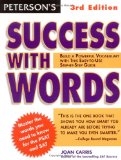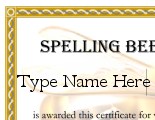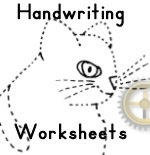Vocabulary is Important
Vocabulary is vital to communicating with others and understanding what one is reading. I know that information is known to everyone, but acknowledging it instead of taking it for granted adds important goals to your child's list of basic skills to master.
If your child is struggling with reading comprehension, then add more concentration of studying words in context. Encourage your children to look up words that they do not understand. Each of my children had their own small dictionary and thesaurus.
Vocabulary is the study of:
- The meanings of words
Many words have several different meanings each, study the meanings of the words and the part of speech. - How the words are used
Study the words in context, apply what you learn by writing sentences with your words. - Root words, prefixes, suffixes
Studying these will aid in the study of vocabulary. - Analogies
This is comparing two pairs of words and choosing the pair that go together.
example:
Book : Backpack::
(A) clothing : dresser
(B) china : silver
(C) documents : portfolio
(D) relic : museum
(E) research : laboratory
answer below
There is more to analogies than the simple one above. Some analogies will require the student to decide what part of speech the words are because many words have more than one definition and will have more than one part of speech. An understanding and knowledge of words and their usage is essential for working advanced analogies. Below are some examples of high school analogies from Peterson's 1999 SAT Success.
| 1. FUEL : BLAZE:: a. burn : incense b. abuse : victim c. provoke : ire d. reward : achievement e. correct : oversight |
2. COMPOUND : ELEMENTS:: a. drawing : composites b. constitution : rulings c. batter : ingredients d. map : countries e. book : series |
3. RALLY : LOSS:: a. edit : essay b. regain : market c. salvage : wreck d. purify : disinfectant e. recover : disease |
About Wordly Wise and Analogies
Wordly Wise Curriculum
The differences between the programs as of this writing, 2002:
Original Wordly Wise & Wordly Wise 3000
I know that everyone has probably heard of Wordly Wise. My kids have used Wordly Wise for years and I have to admit that although the program seems to work, my kids find it a bit dull. There are two as you may have noticed in your catalogs.
Planning Wordly Wise
Wordly Wise A, B, and C are for grades 2, 3, and 4.
Wordly Wise 3000 is the more modern one and they have made a few improvements that I like such as a pronunciation guide with every word. I do not like some of the reading selections [activity E] and activity C [Applying Meanings] can be a problem sometimes. Some of books in this series have analogies, but I do not think any instruction is provided on how to work them.
Original Wordly Wise is very good too and I do not dislike any of it. The kids do have to look up the words in the back of the book though [unless they have changed it] and they might balk about that, but it is good practice.
Analogies
Analogies 1, 2, and 3
These books are for 7-12 grades students. They are excellent for
teaching analogies. Each book has numerous analogies to work and 300
vocabulary words.

Some SAT preparation books have analogy practice and vocabulary. We used the wonderfully written but out of print Peterson's Success with Words 3rd Edition (pictured on the right). Used copies can still be purchased very cheaply (as of this writing-9/2011). I used this book as one of my examples on "How to Make Lesson Plans" on this page: Lesson Plans for Peterson's Success with Words.
Resources for words
This link will take you to my Word Study page. There are links there that might be helpful.
Answers to advanced analogies:
1. c You fuel a blaze to make it burn more hotly. You provoke ire to make it burn more hotly.
2. c A compound is a new substance made up of two or more elements. A batter is a new substance made up of two or more ingredients.
3. e To rally is to get over a lose. To recover is to get over a disease.
answer to analogy question:
C. documents : portfolio
explanation: Type: object and logical place. A book is carried in a backpack (usually)...just as a document is carried in a portfolio.
The other words: clothes are kept in a dresser like books are kept in a backpack, but they are not being toted around. Relics are kept in a museum (usually) but the museum is not the means of transporting the relics like a backpack transports the books.More Information:
One of the usual ways to work an analogy is to make a simple sentence from the words. An effective sentence will show the relationship between the two words.To clarify what I mean, I will show an example using the words from above.
Book : Backpack::
(A) clothing : dresser
(B) china : silver
(C) document : portfolio
(D) relic : museum
(E) research : laboratorySentences using the words Book : Backpack:::
A book is in a backpack. [While this is true is doesn't really demonstrate the relationship between the words. If we had settled for this sentence then the analogy would have been difficult to solve]
A book is carried in a backpack. [This sentence is better]Now we substitute the other words in the sentence:
(A) Clothing is carried in a dresser. [untrue]
(B) China is carried in silver [not even close]
(C) A document is carried in a portfolio. [it fits, but we will still check the others]
(D) A relic is carried in a museum. [not quite true]
(E) Research is carried in a laboratory. [not exactly]It looks like C is the winner.
I want you to think about this---
If I had settled for the first sentence- A book is in a backpack. - then A and D would have been true. It is important to make a very good, simple sentence that shows the relationship between the two words.



 About Keys
About Keys V Planner
V Planner XLS Composition Grader
XLS Composition Grader


